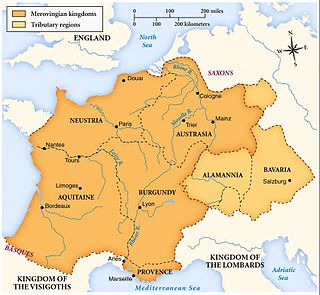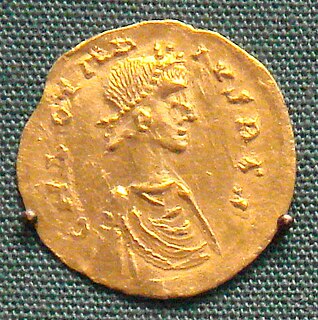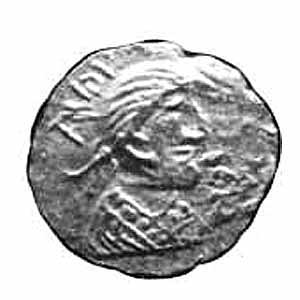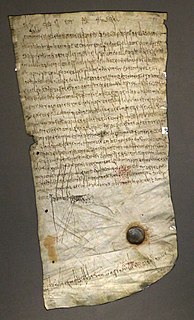Family
According to Fredegar, he was a relative (consanguineus) of Dagobert I's mother. Chaume cites the Notitia de Fundatione Monasterii Glanderiensis to suggest that Erchinoald was son of the Gallo Roman senator Ansbertus, and that Erchinoald's son, Leudesius, was therefore a descendant of the Gallo-Roman families of the Syagrii and Ferrèoli [1] [2] Erchinoald's relationship with Merovingian King Dagobert has been proposed to have been through his mother Gerberga, daughter of Burgundian dux Ricomeres (fl. 575) and Bertrude, her putative sister, and mother of King Dagobert. [3] [4] According to Alban Butler, Erchinoald was brother to Adalbard of Ostrevent and Sigefrid, count of Ponthieu. [5] Herchenfrida (Erchinfreda), mother of St. Desiderius of Cahors will have also been of this family as is further evidenced inter alia by that Gallo-Roman saint's close ties to King Dagobert, and a brother named "Syagrius".
Erchinoald introduced Balthild, an Anglo-Saxon slave, most probably of a high-ranking Anglo Saxon family from East Anglia (later canonised), to Clovis II, king of Neustria. The king's marriage to the pious Balthild reinforced Erchinoald's position at court. It has been suggested given the rarity of the name element "Erchin" (Genuine or truly) among the Franks and Saxons that Queen Emma of Kent, thought to be from Frankia, and the wife of Eadbald of Kent was of this family and perhaps Erchinoald's daughter. Eadbald and Emma had a son Eorconbert b. ca. 618 so Emma was probably born before 600 and was not a daughter but a sister or less likely a cousin of Erchinoald. This was a period of considerable Frankish influence in Kent and East Anglia and as one of the most powerful men in Frankia located at his estate at Peronne not far from the English channel when he was not at court, it was Erchinoald who wielded this influence during his lifetime. Erchinoald supported efforts of successors of the Augustinian mission to England. One notable manner in which he both exerted influence and aided the mission was his involvement in and support of convents within his sphere of influence in Neustria (for example Faremoutiers) into which some of the princesses of Kent, such as Eorcongota and East Anglia such as Aethelburg and Saethryth, in most cases his relations, retired and were made abbess. [6]
Erchinoald himself married Leutsinde. [7] Through her he had a son, Leudesius, who became the mayor of the palace of Neustria in 675.
Erchinoald died in 658 and was succeeded by Ebroin, chosen by the Frankish nobles. Although his son, Leudesius, and much of his family were destroyed in the conflict between the factions of Leudegar of Autun and Ebroin in 676, the name does resurface in the 7th century in Frankia suggesting he may have had some descendants who survived; Chaume has posited a sister who was ancestor to a number of powerful families during the Carolingian era such as the Guerinids, the counts of Gatinais, and the Guidonids. [8]

The Merovingian dynasty was the ruling family of the Franks from the middle of the 5th century until 751. They first appear as "Kings of the Franks" in the Roman army of northern Gaul. By 509 they had united all the Franks and northern Gaulish Romans under their rule. They conquered most of Gaul, defeating the Visigoths (507) and the Burgundians (534), and also extended their rule into Raetia (537). In Germania, the Alemanni, Bavarii and Saxons accepted their lordship. The Merovingian realm was the largest and most powerful of the states of western Europe following the breaking up of the empire of Theodoric the Great.
The 650s decade ran from January 1, 650, to December 31, 659.

Year 673 (DCLXXIII) was a common year starting on Saturday of the Julian calendar. The denomination 673 for this year has been used since the early medieval period, when the Anno Domini calendar era became the prevalent method in Europe for naming years.

Chlothar II, called the Great or the Younger , was king of Neustria and king of the Franks, and the son of Chilperic I and his third wife, Fredegund. He started his reign as an infant under the regency of his mother, who was in an uneasy alliance with Chlothar's uncle King Guntram of Burgundy, who died in 592. Chlothar took power upon the death of his mother in 597; though rich, Neustria was one of the smallest portions of Francia. He continued his mother's feud with Queen Brunhilda with equal viciousness and bloodshed, finally achieving her execution in an especially brutal manner in 613, after winning the battle that enabled Chlothar to unite Francia under his rule. Like his father, he built up his territories by seizing lands after the deaths of other kings.

Neustria was the western part of the Kingdom of the Franks.

Chlothar III was the eldest son of Clovis II, king of Neustria and Burgundy, and his queen Balthild. When Clovis died in 657, Chlothar succeeded him under the regency of his mother. Only a month beforehand, according to the near-contemporary Life of Eligius by the courtier Audoin (bishop) of Rouen, Saint Eligius had prophesied the death of Clovis, Balthild's downfall, and Chlothar's short reign.

Childeric II was the king of Austrasia from 662 and of Neustria and Burgundy from 673 until his death, making him sole King of the Franks for the final two years of his life.

Ebroin was the Frankish mayor of the palace of Neustria on two occasions; firstly from 658 to his deposition in 673 and secondly from 675 to his death in 680 or 681. In a violent and despotic career, he strove to impose the authority of Neustria, which was under his control, over Burgundy and Austrasia.
Under the Merovingian dynasty, the mayor of the palace or was the manager of the household of the Frankish king.

Eadbald was King of Kent from 616 until his death in 640. He was the son of King Æthelberht and his wife Bertha, a daughter of the Merovingian king Charibert. Æthelberht made Kent the dominant force in England during his reign and became the first Anglo-Saxon king to convert to Christianity from Anglo-Saxon paganism. Eadbald's accession was a significant setback for the growth of the church, since he retained his people's paganism and did not convert to Christianity for at least a year, and perhaps for as much as eight years. He was ultimately converted by either Laurentius or Justus, and separated from his first wife, who had been his stepmother, at the insistence of the church. Eadbald's second wife was Emma, who may have been a Frankish princess. She bore him two sons, Eormenred and Eorcenberht, and a daughter, Eanswith.

Clovis II was King of Neustria and Burgundy, having succeeded his father Dagobert I in 639. His brother Sigebert III had been King of Austrasia since 634. He was initially under the regency of his mother Nanthild until her death in her early thirties in 642. Nanthild's death allowed Clovis to fall under the influence of the secular magnates, who reduced the royal power in their own favour; first Aega and then Erchinoald. The Burgundian mayor of the palace Flaochad used him to lure his rival, Willebad, to a battle in Autun, where Willebad was killed.

Balthild, also spelled Bathilda, Bauthieult or Baudour, was queen consort of Neustria and Burgundy by marriage to Clovis II, the King of Neustria and Burgundy (639–658), and regent during the minority of her son. Her hagiography was intended to further her successful candidature for sainthood.

Francia, also called the Kingdom of the Franks, Frankish Kingdom, Frankland, or Frankish Empire, was the largest post-Roman barbarian kingdom in Western Europe. It was ruled by the Franks during Late Antiquity and the Early Middle Ages. After the Treaty of Verdun in 843, West Francia became the predecessor of France, and East Francia became that of Germany. Francia was among the last surviving Germanic kingdoms from the Migration Period era before its partition in 843.

Dagobert II was the Merovingian king of the Franks ruling in Austrasia from 675 or 676 until his death. He is one of the more obscure Merovingians. He has been considered a martyr since at least the ninth century.

Theuderic III was the king of Neustria on two occasions and king of Austrasia from 679 to his death in 691. Thus, he was the king of all the Franks from 679. The son of Clovis II and Balthild, he has been described as a puppet – a roi fainéant – of Ebroin, the Mayor of the Palace, who may have even appointed him without the support of the nobles.

Leodegar of Poitiers was a martyred Burgundian Bishop of Autun. He was the son of Saint Sigrada and the brother of Saint Warinus.

Audoin was a Frankish bishop, courtier, hagiographer and saint.
The Christianisation of Anglo-Saxon England was a process spanning the 7th century. It was essentially the result of the Gregorian mission of 597, which was joined by the efforts of the Hiberno-Scottish mission from the 630s. From the 8th century, the Anglo-Saxon mission was, in turn, instrumental in the conversion of the population of the Frankish Empire.
Emma was a member of the Austrasian royal family. She is sometimes identified with the Emma who married Eadbald of Kent.
Adalbert I of Ostrevent was a 7th-century Frankish nobleman of the court of King Clovis II of France. He is recognized as a saint, and is commemorated on both 2 February and 2 May.
 This article incorporates text from this source, which is in the public domain.
This article incorporates text from this source, which is in the public domain.













